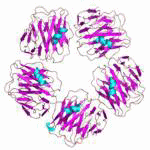Molecular Biology
|
13 may 2022 09:58:58 |
| Molecules, Vol. 27, Pages 3123: Antimicrobial, Antigenotoxicity, and Characterization of Calotropis procera and Its Rhizosphere-Inhabiting Actinobacteria: In Vitro and In Vivo Studies (Molecules) |
|
Tweet Calotropis procera (C. procera) is a wild shrub that is a medicinal plant found in abundance throughout Saudi Arabia. In this study, we investigated the phytochemical composition and antigenotoxic properties of the ethanolic extract of C. procera, in addition to the antimicrobial activity of the plant and its rhizospheric actinobacteria effects against pathogenic microorganisms. Soil-extract medium supplemented with glycerol as a carbon source and starch–casein agar medium was used for isolation of actinobacteria from rhizosphere. From the plant, a total of 31 compounds were identified using gas chromatography/mass spectrometry (GC–MS). The main components were α-amyrin (39.36%), lupeol acetate (17.94%), phytol (13.32%), hexadecanoic acid (5.55%), stigmasterol (3.16%), linolenic acid (3.04%), and gombasterol A (2.14%). C. procera plant extract’s antimicrobial activity was investigated using an agar well-diffusion assay and minimum inhibitory concentration (MIC) against six pathogenic microbial strains. The plant extract of C. procera was considered significantly active against Staphylococcus aureus, Klebsiella pneumonia, and Escherichia coli, with inhibition zones of 18.66 mm, 21.26 mm, and 21.93 mm, respectively. The plant extract was considered to be a moderate inhibitor against Bacillus subtilis, with MIC ranging from 0.60–1.50 mg/mL. On the other hand, the isolated actinobacteria were considered to be a moderate inhibitor against S. aureus (MIC of 86 µg/mL), and a potent inhibitor, strain CALT_2, against Candida albicans (MIC of 35 µg/mL). The 16S rRNA gene sequence analysis showed that the potential strains belonged to the genus Streptomyces. The effect of C. procera extract against cyclophosphamide (CP)-induced genotoxicity was examined by evaluating chromosome abnormalities in mouse somatic cells and DNA fragmentation assays. The current study revealed that oral pretreatment of C. procera (50, 100, and 200 mg/kg b.w.) for 1, 7, and 14 days to cyclophosphamide-treated animals significantly reduced chromosomal abnormalities as well as DNA fragmentation in a dose-dependent manner. Moreover, C. procera extract had antimicrobial and antigenotoxic effects against CP-induced genotoxicity. |
| 118 viewsCategory: Biochemistry, Chemistry, Molecular Biology |
 Molecules, Vol. 27, Pages 3122: Within the Ischemic Penumbra, Sub-Cellular Compartmentalization of Heat Shock Protein 70 Overlaps with Autophagy Proteins and Fails to Merge with Lysosomes (Molecules) Molecules, Vol. 27, Pages 3122: Within the Ischemic Penumbra, Sub-Cellular Compartmentalization of Heat Shock Protein 70 Overlaps with Autophagy Proteins and Fails to Merge with Lysosomes (Molecules)Molecules, Vol. 27, Pages 3124: Synthetic and Nanotechnological Approaches for a Diagnostic Use of Manganese (Molecules) 
|
| blog comments powered by Disqus |
MyJournals.org
The latest issues of all your favorite science journals on one page
The latest issues of all your favorite science journals on one page



